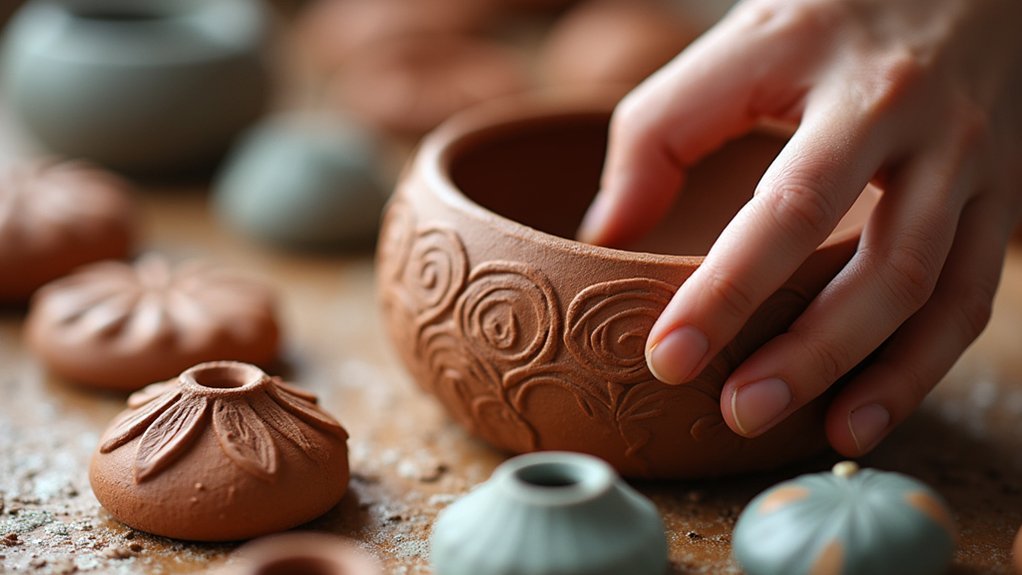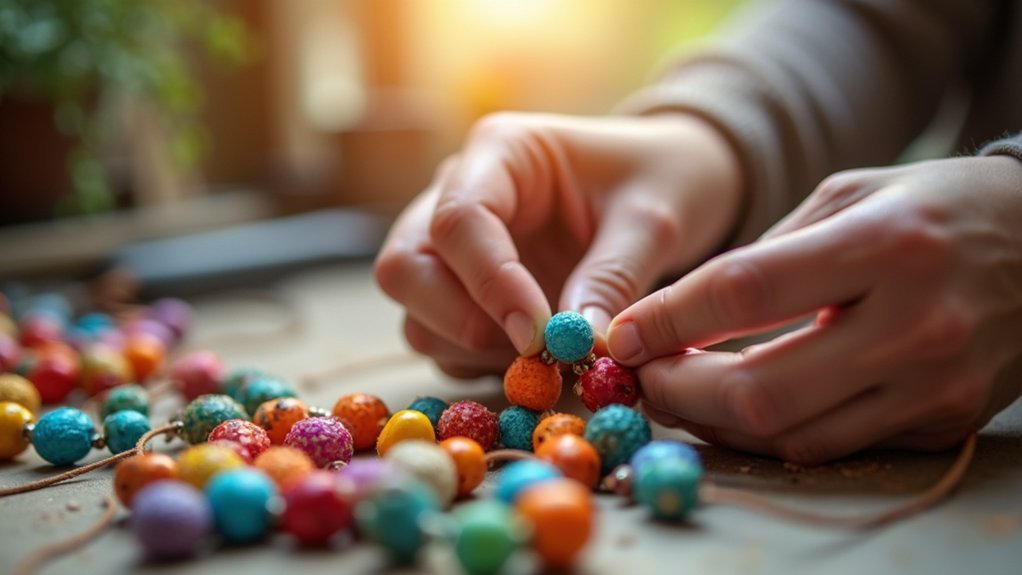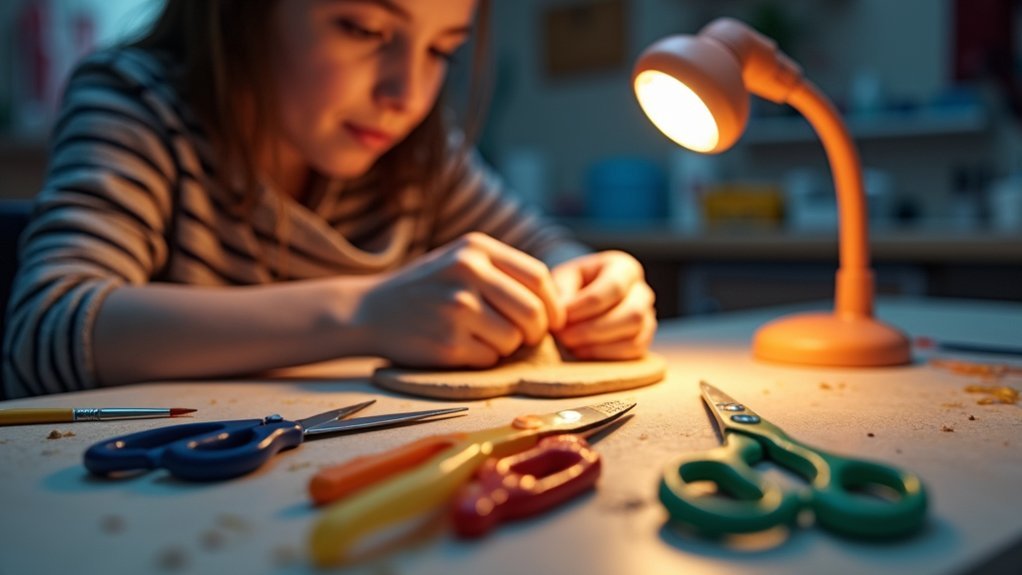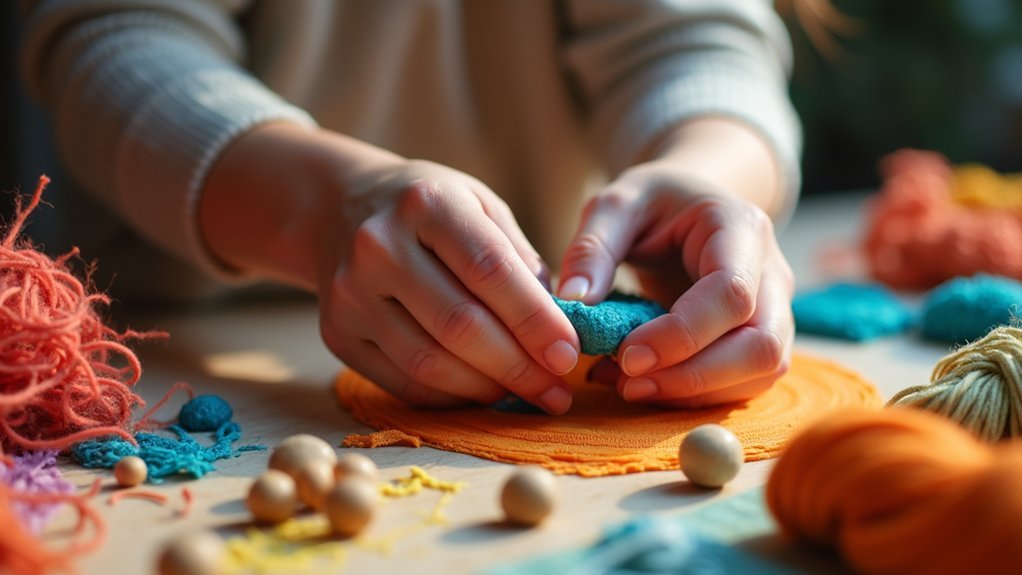Crafts with strong tactile components work best for visual impairments. You’ll thrive with clay pottery, which provides immediate feedback as you shape three-dimensional forms. Textured fiber crafts like knitting and weaving offer rhythmic, touch-based techniques using larger needles. Jewelry making with distinct beads and paper crafts with raised elements can be highly accessible. With proper lighting, adaptive tools, and organized workspaces, your artistic expression can flourish beyond visual limitations. Discover how these sensory-rich activities can transform your creative journey.
Tactile Arts: Clay and Pottery Techniques

Kneading a lump of clay between your fingers opens a world of artistic possibilities for those with visual impairments. Clay’s malleable nature provides immediate tactile feedback, allowing you to form and explore three-dimensional shapes without relying on sight.
You’ll find pottery particularly accessible as you can feel the clay transforming beneath your fingertips, creating bowls, vases, or sculptures through touch alone. Specialized tools can enhance your grip and control, making detailed work achievable regardless of vision limitations.
As you work with clay, you’re also developing fine motor skills and hand strength. The medium encourages experimentation—there’s no right or wrong way to express yourself.
Many people with visual impairments discover that pottery becomes not just a craft but a meaningful form of personal expression and creativity.
Fiber Crafts: Knitting and Weaving by Touch
When selecting yarn for knitting or weaving projects, you’ll benefit from choosing textured options like wool or cotton-blend yarns that provide clear tactile feedback as you work.
You can count stitches effectively by developing a rhythmic touching technique, running your fingertips along each stitch while mentally tracking your progress.
Using stitch markers with distinct textures at key intervals will help you maintain pattern accuracy without relying on visual cues.
Tactile Yarn Selection
Choosing the right yarn makes all the difference for visually impaired crafters engaging in knitting or weaving projects.
Select tightly woven, bright-colored fibers to enhance visibility and provide better tactile feedback. Textured yarns like boucle or chenille offer distinct sensations that help you track your progress through touch alone.
Pair your yarn choices with mid to large-sized needles for easier handling and improved control during your creative process.
- Feel the satisfaction of completing a row using yarn that speaks to your fingertips
- Experience the joy of identifying colors through texture and weight differences
- Discover newfound independence as tactile yarns guide your creative journey
- Embrace the pride of creating beautiful pieces despite visual challenges
- Enjoy the therapeutic calm that comes from working with materials chosen just for you
Counting Stitches Effectively
Five essential techniques transform counting stitches from a visual task into a tactile experience. When you’re visually impaired, place rubber bands or textured yarn as markers at key points in your work. These tactile markers create reference points you can easily feel as you progress.
Develop your sense of touch by feeling each stitch on your needle or loom. This builds spatial awareness of your pattern without relying on sight. Maintaining consistent tension gives you predictable tactile feedback—uniform stitches are easier to count by touch.
Establish a counting routine after each row or section to reinforce your memory of the pattern.
Finally, consider adaptive tools like tactile stitch counters or audio devices that announce your count. These approaches make counting stitches accessible regardless of visual ability.
Sensory-Rich Jewelry Making With Beads

You’ll find jewelry making with beads offers a uniquely tactile experience, allowing you to identify different beads through touch and associate textures with specific colors.
Various threading tools have been adapted with wider grips, magnetic clasps, and bead trays with divided sections to make the crafting process more accessible.
These adaptations, combined with intentional texture-coding of your beads, can transform a potentially challenging craft into an enjoyable creative outlet that showcases your personal style.
Tactile Bead Identification
The world of beadwork opens up exciting possibilities for visually impaired crafters through tactile identification techniques.
You’ll discover that beads with distinct textures, sizes, and materials provide a rich sensory experience that helps you differentiate components by touch alone. Opt for larger beads with wider holes for easier threading and select pieces with raised patterns or unique surface characteristics.
- Feel the satisfying texture of wooden beads against your fingertips as you create
- Experience the cool, smooth surface of glass beads that transforms into wearable art
- Discover the empowering independence of identifying Braille-marked beads
- Enjoy the pride of creating personalized jewelry that expresses your unique style
- Celebrate the accomplishment of mastering a tactile craft that engages your senses
Color-Coding Through Texture
While most people associate colors with visual recognition, you can develop an intuitive color-coding system through texture when creating sensory-rich jewelry. For visually impaired crafters, distinct surface patterns become your visual guide.
| Texture Type | Color Association |
|---|---|
| Smooth | Light colors (white, yellow) |
| Ridged | Bold colors (red, blue) |
| Bumpy | Dark colors (black, brown) |
Select beads with consistent tactile patterns for each color family. You’ll soon identify “red” by feeling ridged surfaces or “yellow” through smooth contours. Combine these with Braille-marked beads for additional identification. This system transforms jewelry making from a visual craft to a fully tactile experience, allowing you to create intricate designs independently while enhancing your fine motor skills and creative expression.
Threading Tools Adaptations
Successful jewelry making for visually impaired crafters requires thoughtfully adapted threading tools that transform potential frustrations into seamless creative experiences.
When designing activities for visually impaired individuals, select longer beading needles with wider eyes that make threading considerably easier. Self-threading needles and specialized beading boards with raised outlines help organize materials and maintain project structure.
- Feel the surge of independence as you navigate your craft with Braille-labeled bead containers
- Experience the satisfaction of self-sufficiency when using tactile markers to identify colors
- Enjoy the confidence that comes with masterfully manipulating larger, textured beads
- Discover the empowerment of creating beautiful jewelry using adaptive tools designed for your needs
- Embrace the sense of accomplishment as audio guides lead you through each successful step
Adaptive Tools and Lighting for Comfortable Crafting

Creating accessible crafting environments begins with the right tools and lighting for individuals with visual impairments. You’ll find that adjustable flex-arm lamps with built-in magnifiers can greatly reduce eye strain when working on detailed projects. Task lighting eliminates shadows and enhances material visibility, making your crafting sessions more productive.
| Adaptive Tools | Benefits |
|---|---|
| Magnifiers | Focus on intricate details for precision work |
| Audible-feedback scissors | Safer cutting without relying on sight |
| High-contrast materials | Easier distinction between crafting elements |
Consider incorporating these specialized adaptive tools into your crafting space. Brightly colored yarns and fabrics improve visibility, while crafting-specific magnifiers allow you to execute detailed work like beading or sewing with greater confidence and comfort.
Multi-Sensory Paper Crafts and Collage Making
Paper crafts and collage making offer rich multi-sensory experiences that extend beyond visual engagement. When you’re visually impaired, these activities can stimulate your tactile senses through textured materials like fabric, sandpaper, and foil.
You’ll find high-contrast, brightly colored papers help distinguish between elements if you have low vision, while raised-line techniques and dimensional glue create tangible borders you can feel.
- Feel the satisfaction as your fingers discover different textures coming together in your creation
- Experience the joy of independence as tactile feedback guides your artistic process
- Delight in the surprising crinkle of specialty papers adding auditory elements
- Build confidence as your fine motor skills improve with each project
- Embrace the freedom of creative expression without vision limitations
Setting Up an Accessible Craft Space at Home
When your home environment supports your creative needs, crafting becomes both more enjoyable and accessible despite visual impairments. Designate a well-lit area equipped with adjustable task lamps featuring built-in magnifiers to reduce eye strain.
For the visually impaired, organization is essential. Store materials in containers with Braille or tactile labels for easy identification. Use contrasting colored trays to distinguish materials from your workspace, and incorporate non-slip mats to prevent items from shifting during your creative process.
Transform your accessible craft space into a sensory-rich environment with textured surfaces and pleasant ambient sounds that stimulate creativity.
These thoughtful adaptations don’t just make crafting possible—they make it an engaging, frustration-free experience where your artistic vision can flourish regardless of visual limitations.
Finding Community Support for Visually Impaired Crafters
Although crafting can be enjoyed independently, connecting with a supportive community greatly enhances the creative experience for visually impaired crafters. Engaging with local organizations offers hands-on guidance while online forums provide valuable opportunities to share techniques and celebrate achievements.
Community resources like the RNIB specifically cater to visually impaired individuals with specialized crafting tools and adaptive methods.
- Feel the warmth of belonging when joining adaptive craft groups where everyone understands your challenges
- Experience the joy of discovery when fellow crafters share innovative solutions you hadn’t considered
- Build confidence through encouragement from others who’ve mastered similar techniques
- Find inspiration in the remarkable creations shared by visually impaired artists worldwide
- Celebrate your progress with people who truly appreciate the unique journey you’re on
Frequently Asked Questions
What Crafts Can Elderly With Poor Eyesight Do?
You can enjoy tactile crafts like knitting with larger yarns, jewelry making with big beads, pottery, clay sculpting, sewing with high-contrast fabrics, and textured paper collages despite poor eyesight. They’ll enhance your creativity and dexterity.
What Is a Hobby for Someone Who Cant See Well?
You’ll enjoy tactile hobbies like pottery, beadwork with larger beads, knitting with textured yarn, or adapted sewing. These crafts enhance your sense of touch while creating beautiful items without relying heavily on vision.
How Do Visually Impaired People Enjoy Art?
You’ll enjoy art through touch using tactile techniques like textured painting and raised-line drawing. You can explore pottery, jewelry making, and beadwork, which offer multi-sensory experiences that engage your other senses besides sight.
What Are Some Projects to Help Blind People?
You’ll find success with tactile crafts like clay sculpting, large-bead jewelry, or adapted knitting using textured materials. Try raised-texture painting, audio-described creative workshops, or sensory gardens that engage through touch and smell.
In Summary
You’ve got so many options for crafting with visual impairments! Whether you’re molding clay, weaving textiles, stringing beads, or creating textured collages, focus on what feels right for your abilities. Don’t forget to set up your space with proper lighting and adaptive tools. Remember, you’re not alone—connect with other visually impaired crafters to share techniques and inspiration. Your creativity isn’t limited by your vision!





Leave a Reply